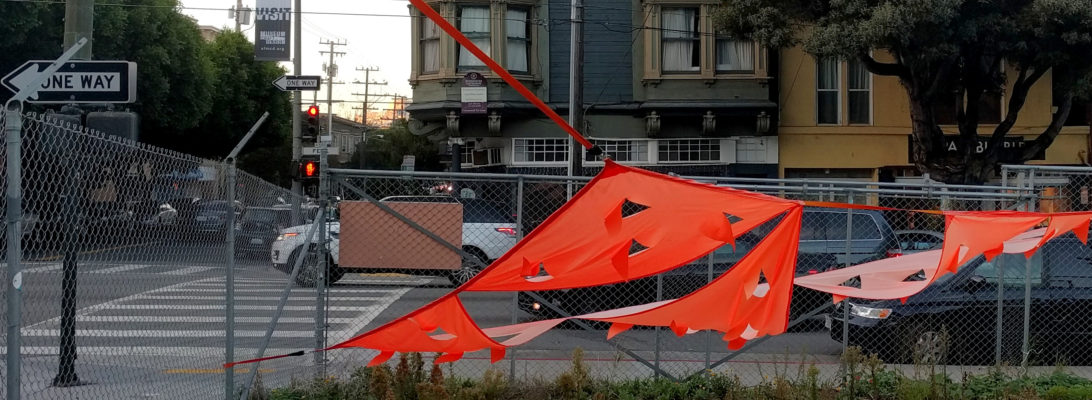ello everyone. This week’s streetwalk is off-road. Thus, less architecture and urbanism talk, and a bit more marine biology. Join me on the west side of San Francisco, where the Pacific Ocean crashes into the land. I hopped on my bike and rode from my apartment, through the Panhandle, on down through Golden Gate Park, then up the super steep hill past Cliff House. Almost at the top of the hill, I came to Land’s End, home of a new visitor’s center (replacing porta potties!), a large parking lot, and a view over the Sutro Baths. Usually full of tourists, there are several walking paths that branch off down and right out of the lot. I locked up my bike and headed straight for my favorite destination, the Land’s End Trail down to Mile Rock Beach (I always just call it Land’s End beach….). I planned to walk the labyrinth perched above the beach, but I’m so uncentered I’m not sure one labyrinth walk is going to do the trick. At the point above the beach look right: there’s the Golden Gate Bridge.

Look left: there’s Mile Rock Beach, a nice low tide, with sea mist and green spring growth carpeting the cliffside.

And here’s the labyrinth. Its quite nice, you should really visit. If there aren’t too many people visiting, you can walk it all by yourself while you enjoy the crash of the waves, the diving seabirds, and the illusion that there are no cars, houses, or people nearby.

Walking down the cliff to the beach, the ice plant is in bloom. I know its boring, and invasive, but ever since we moved out West I’ve loved the look of its spiky green branches dotted with hot pink cup shaped blossoms. I’ve Googled so you don’t have to: its botanic name is Carpobrotus edulis, and one of the common names that always struck me is “Hottentot Fig” – doesn’t that sound a little, I don’t know, colonialist and reminiscent of the 1800s? Let’s call it Ice Plant. Its native to South Africa but likes coastal California very much. Its considered invasive in the Mediterranean and New Zealand too. Apparently you can eat its fruit – “sour figs” – but I’ve never spotted one. Have you?

I headed down to the beach, excited to see that it was low tide. Even though the low mark had been hours before the water was still well out – low enough to expose most of the rocks that are usually buried in crashing surf when I visit. I peeked under the largest boulder near the beach to find this sweet cluster of aggregating anemones with pinkish tentacles buried in sand. You can the one above the waterline is closed to protect its tentacles.

Check out this gooey cluster of aggregating anemones hanging from the rock!. There are tons of them everywhere around the mid-tide line. They open up underwater but look rather gross when they’re retracted and out of water. Anthopleura elegantissima are actually CLONES! Yes, all those anemones are genetically identical and branched off from one another. Even more wierdly, different clone groups are enemies, and will sting each other if a cluster gets close to a different cluster.

Look at that giant green….butthole? I know you were thinking it. But its actually a giant green anemone Anthopleura xanthogrammica. What a great name for a giant bulbous awesome anemone. I never get to see these guys, the tide usually isn’t low enough. They live a little deeper out, past the aggregating clone anemones, and around where you start to see clusters of mussels crowding the rocks. I’ve just learned that this is because they like to eat mussels, and as the starfish cruise through the mussel beds, knocking them off, these guys get a mussel treat when they fall down toward their buttholes…I mean, mouths. Actually – it is a butthole. Yes, anemones eat and eject waste from the same opening – who knew!

Look at the size of these things.

This one just had its tentacles open underwater before the tide sucked back out again.

This guy is in defensive posture. I think its a “shield backed kelp crab” – because of its distinctive shape. But I’m not sure how common it is for it to be dark red like that.

Here is a mossy chiton. An overlooked little intertidal mollusk. It clings onto the rock and rasps delicious algae off with its barbed radula (tongue like). It really anchors itself on there – not going anywhere.

When its low tide, the further rocks are really completely encrusted with barnacles, mussels, and gooseneck barnacles (the white ones, below). Have you ever eaten a gooseneck barnacle? I haven’t – looks like a lot of work for the meat.

Look at those rocks, totally encrusted. Its the perfect habitat for …

The big hunter, the Ochre Sea Star (below). They love to chow on mussels and wrap their bodies around mussel, pry it open with their sticky leg tubercules, and then eject their stomach pouch down in there to digest some sushi.

Headed back out – this streetwalk has a lot of stairs.

Oh – and Jesus was here.

Gorgeous outlook over the Pacific with a scalloped mackerel sky and cypresses in the foreground.

Back across the parking lot to my steed – the only one on the bike rack this fine afternoon.

This was mostly a nature streetwalk, but on my way up and out of Land’s End I had to snap a shot of a building a love to hate – this pistachio-mint-green building right on the corner of Geary. It actually works in this photo, contrasting with the blue and white sky and the zebra striped crossing. The building is a tragedy, but “at least” its not beige, right? (see neighbor building)

